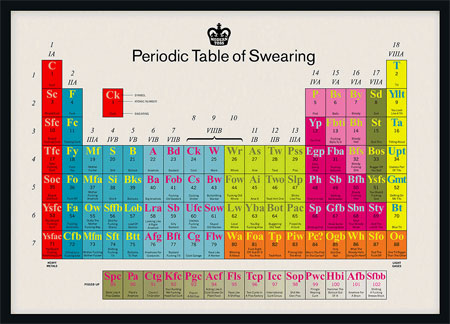This post’s image comes from my coworker Darrough, though I know not the original author of the piece. The graphic is a periodic table of swear words and so for those with sensitive ears—or perhaps eyes—I shall advise you to skip forthwith this post. Now, in general, there is little remarkable about the graphic. Many different subject matters have borrowed the motif to organise themselves.

There are a few things lacking that would make the graphic a touch more interesting; one would be some sort of rationale for as to why the author placed certain swear words into different groups. In the table for the chemical elements, the elements are arranged by their electron shells and number of protons, groups and periods. For example, the alkali metals are the first group and are among the most reactive chemical elements. Is there a link between the reactivity of lithium to that of saying cunt? Is there a link between the non-reactive elements in the noble gases, e.g. argon, and those swear words originating with the word tit? One might ordinarily assume that the first group are the most reaction-provoking swear words whereas the last group is the least reactive. However, I know people equally offended by both words.
Another interesting consideration is the colour of the piece. Broadly speaking, the colours resemble those typically seen in colouration of groups of similar elements. For example, the first few periods of Groups 14–16 share either a pink or violet-red depending upon where they fall along a diagonal axis. In the chemical element table, a three-way division of elements appears with the divisions delineating the non-metals from the metalloids from the metals. Is there a similar reasoning for the division in this chart? If so, the reason does not readily appear to me.
Another interesting note is that the ‘pissed up’ group replaces the lanthanides and actinides—which contain uranium and plutonium. However, the ordering by atomic number is incorrect and I would be curious in knowing if there is any particular reason for that decision.
One final consideration is that because I know not the origin of the piece, I cannot know the cultural background by the selection. For example, as an Anglophile American, I know well the use of bloody, twat, arse, and bollock among other words. However, most Americans would have other choice words to use in their place. Is this piece an attempt to classify perhaps British/English/Scottish swearing or is it an attempt to try and fit many English-language swear words into a single table? If the latter, I would be curious to see if there are any words of, say, Canadian, Australian, South African, or New Zealander origin that have been excluded.
All told, however, this piece is just downright entertaining and in all likelihood the author intended it to be as such. (Though I would be most curious to see an etymologically correct attempt at defining English swear words.) Aesthetically, the piece fits into the style of most old-fashioned textbook diagrams that I have seen in old textbooks.
So, all-in-all, I can sum this piece up in two words. Fucking brilliant.
